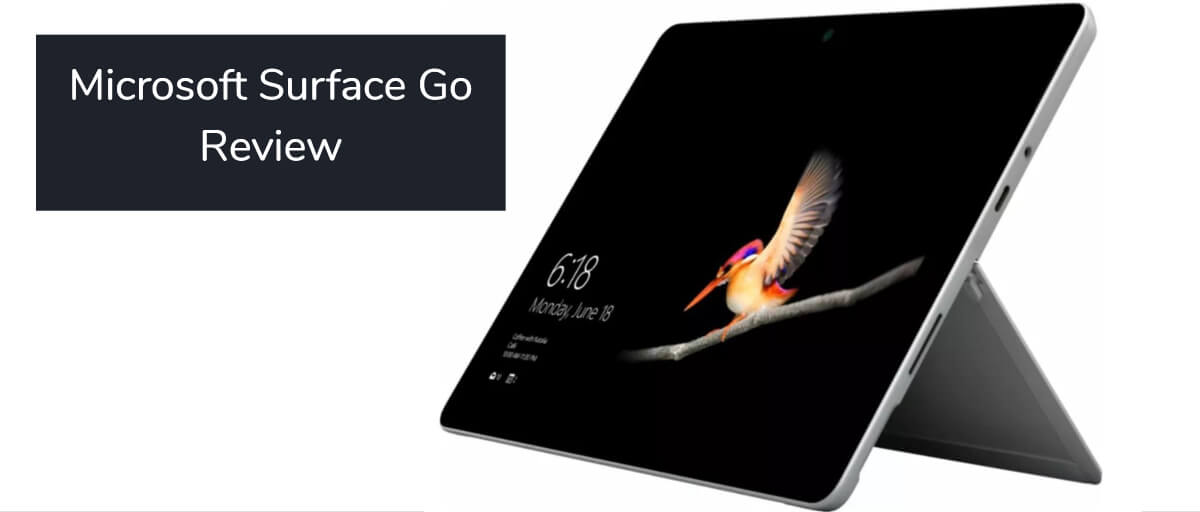Table of Contents
Last Updated on March 29, 2020
If you have always been curious about the Microsoft Surface but were put off by the high price, this latest Surface could be for you. The Microsoft Surface Go is an affordable entry level 2-in-1, which competes price-wise with many mid-level tablets.
Affordable and Microsoft are two words you rarely hear in the same sentence. How much has Microsoft had to trim on this cheaper model?
Specifications
Design
The Microsoft Surface Go features the same magnesium alloy chassis of the Pro, just with slightly more rounded corners.
One change to the design is the larger bezels around the display, which may make the tablet easier to hold, but it looks dated next to rivals. Microsoft could maybe have fitted an 11-inch display if it wasn’t for the huge bezels.
Where this tablet offers an advantage over the more expensive Surface Pro is the USB-C port, unfortunately not Thunderbolt 3 though. This port offers an additional way of charging your Surface, and hooking it up to an external display.
You will also find a proprietary Surface connector for handling power, and the usual power button, volume rocker and headphone jack, on the outer edges.
Around the back is the same industry-leading kickstand of the Surface Pro. This enables you to easily turn the tablet into a propped up display, or it folds nearly flat for use as a digital canvas. Behind the kickstand sits the microSD card slot, which can be used to expand the memory—Apple, please take note!
Display
Into the elegant chassis, Microsoft has managed to fit a 10-inch PixelSense display, with a resolution of 1,800 x 1,200 pixels—slightly lower than the Surface Pro. The loss of two inches on the display also means the pixel density drops to 217 PPI. Although text and icons look clear on this tablet, it’s by no means the sharpest tablet screen at this price.
As we have come to expect from PixelSense displays, colors are vibrant and fairly accurate, with a healthy amount of contrast and brightness too. Watching movies on this screen when propped up is a pleasure, with the built-in stereo speakers offering a sound which is clear and punchy.
Keyboard and Surface Pen
You might expect the keyboard to feel a bit cramped due to the smaller size, but it is surprisingly comfortable to use. We particularly liked the fact it is back-lit and features a large, glass covered trackpad, which is both responsive and well placed.
The keyboard attaches in the same way as other Surface keyboards, with a magnetic connector to the bottom of the tablet.
There is also an optional Surface Mouse available, but you may find that the trackpad is more than sufficient. A better option is the Surface Pen, that can also be used to point-and-click.
The Surface Pen is aimed at the more creative users, who like to use professional apps to draw, design and edit. However, many will find that the 10-inch display is not large enough to offer the creativity of other Surface models.
Performance and Software
Out go the Intel Core processors and in comes the cheaper Pentium Gold processor from Intel. Although an older technology, it can handle basic, browser-based workloads and productivity apps, like Office 365, with ease.
Surprisingly, the Go is far more capable than you would expect and can even handle photo editing, although larger images may take longer to load.
Windows 10 S, which ships as standard, only allows you to use the Surface Go with Microsoft Edge and programs installed from the Microsoft Store. Although many would argue this is a simpler way of managing Windows, it can also be restrictive with apps like Google Chrome or other browsers not available.
Fortunately, it is easy to switch off the S mode at the touch of a button, for a full Windows 10 Home version. I can’t see any reason why users wouldn’t do this, although it will only run smoothly when multitasking if you have the larger 8GB model.
Battery Life
In tablet mode, and when used as a media consumption device, the battery manages to hit a pretty decent 10-hour mark. Even with brightness cranked up to full, Microsoft claims it will offer nine hours of video playback.
It’s a different story when you connect the official Type Cover, though. Basic tasks, like writing on Google Docs or surfing the web, can zap the battery in just over three and a half hours. It probably won’t be enough to get you through a whole day of lectures without reaching for a power bank or the mains adapter.
Who Should Buy the New Microsoft Surface Go?
The Surface Go is a triumph for Microsoft and proves they can make decent, affordable computers. They have taken everything that was great about the Surface range and distilled it into a much smaller, more wallet-friendly, computer.
For students or people on the go, the Microsoft Go offers a complete laptop replacement, which iOS devices and Android 2-in-1s can’t yet replicate. Although it may not be the best media player, with both Samsung and Apple tablets offering higher resolution screens, it is the best productivity tool.
If you have always wanted to try a Microsoft Surface, now is the time with this great little Surface Go.


